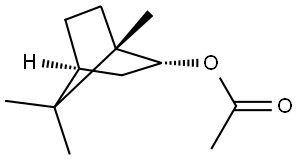Chemical Properties
Bornyl acetate has a fresh, strong, piney odor and a fresh, burning taste.
Chemical Properties
Bornyl acetate occurs in its optically active forms and
as a racemate in many essential oils.
(1S,2R,4S)-(?)-Bornyl acetate is a characteristic component of
most conifer oils. It has a camphoraceous, pine-needle-like odor. Both (1R,2S,4R)-
(+)-bornyl acetate and (?)-bornyl acetate form colorless crystals;
the racemate is a colorless liquid. Bornyl acetate is prepared by
esterification of borneol with acetic anhydride or via the process described under
borneol.
Due to its characteristic pine-needle odor, bornyl acetate is frequently used in
conifer needle compositions, soaps, bath products, room sprays, and pharmaceutical
products.
Occurrence
Reported found in the oils of Abies canadensis, A. concolor, Picea canadensis, P. rubens, P. orientalis, Pinus
densiflora, Larix americana, Callitris drum-mondi, Abies alba, Pinus punulio, Abies sibirica L., and in coriander, thyme and valerian
oil; it has been identified in the essence from flowers of Chrysanthemum sincuse Sabin, in the distillate of Teucrium chamaedris
L., and in the fresh rhizomes of Valeriana officinalis L.; d-bornyl acetate is found in the essential oils of Callitris glauca, C. robusta,
C. gracilis, C. verrucosa and C. calcarata; the presence of acetate has been excluded from the essence of lavender and lavandin.
Uses
Antineoplastic; radioactive agent.
Aroma threshold values
Detection: 75 ppb to 1.38 ppm
Taste threshold values
Taste characteristics at 10 ppm: camphoreous, woody, mentholic, berry and seedy with soapy, woody
nuances.
Synthesis
l-Bornyl acetate occurs naturally in many oils distilled from the leaves of plants of the family Pinaceae; d-bornyl acetate is
found in the oils distilled from plants of the family Cupressaceae; bornyl acetate, therefore may be isolated by distillation and crystallization
from these; however, it is commonly prepared by direct acetylation of borneol; the first synthesis dates to 1889.



